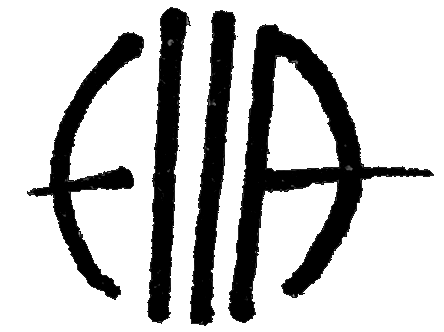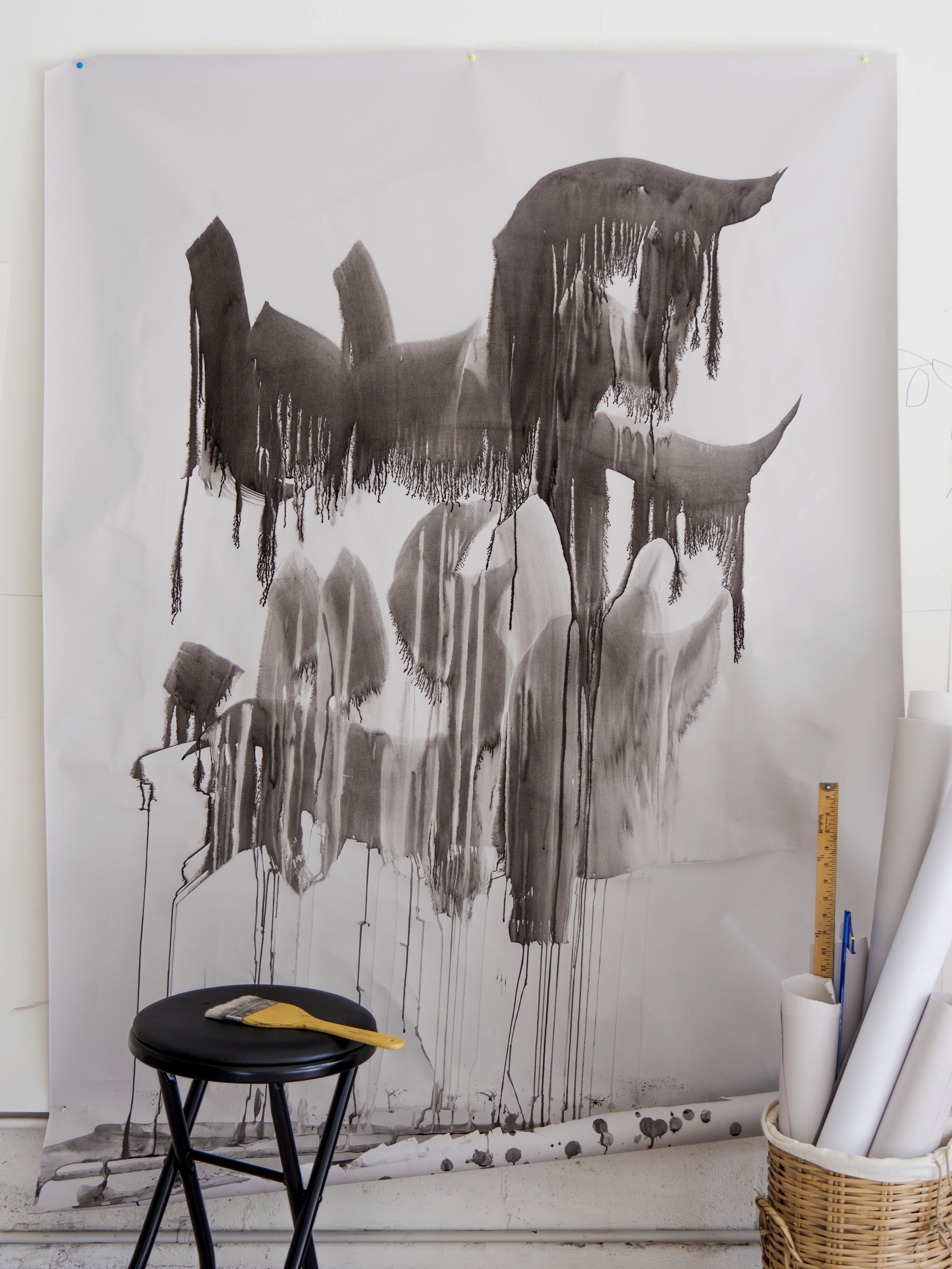Among Refugees Generation Y
Yiddish Prose as Multilingual Calligraphy in the Public Space of Berlin
2017-2019
Concept & Process
Among Refugees Generation Y is a series of multilingual calligraphy murals in the public space of Berlin, inspired by stories by the Yiddish writer, Dovid Bergelson, who lived and worked in Berlin in the 1920s.
Dovid Bergelson (6, on ground with his head on his neighbour’s knee), his wife Zipora (10, seated, second from left), and only son - Prof. Lev Bergelson (5, small child to Bergelson’s left) among a group of friends and colleagues.
The Narrative of Temporality
Sketch in 5 languages
Dovid Bergelson (1884-1952) was already a well known expressionist writer when he was part of an immigration wave that included numerous authors, poets, artists and scholars that settled in Berlin at a time of excitement as literature and art flourished, all-too-briefly, in the European metropolis. A selection of his Berlin stories reappeared in English as The Shadows of Berlin (2005, City Lights Books, San Francisco). Life in Berlin is captured at the precarious moment between world wars - in particular the uneasy existence of intellectual exiles in the new metropolis. The stories offer glimpses into a community and a world now lost. Recently described by Naomi Brenner in the context of Milgroym (a pioneering art and literature journal Bergelson co-edited in Berlin in 1922): "Weimar culture was a heady mix of creativity and anxiety, experimentation and fear, 'the creation of outsiders, propelled by history into the inside, for a short, dizzying, fragile moment.' (Avidov Lipsker). Its’ political and artistic freedom in the early 1920s attracted a variety of Yiddish writers and artists, who mingled with other intellectuals and migrants in a dynamic artistic scene." That generation represents a fracture in time when artistic innovation and experimentation could be allowed and Berlin, due to its affordability in combination with artistic freedom, was the place to allow it.
Of all Bergelson’s stories set in Berlin, Among Refugees is the most prominent and has received the most critical attention. It offers “a study of different forms of existential crisis precipitated by exile”, in the words of Dafna Clifford. In brief, the story is about a well-established Yiddish writer in Berlin who is visited by a strange young man which introduces himself as a Jewish terrorist. He shares with the narrator his life story which is loaded with relocations. He admits to being a writer himself while blending-in another story he has imagined. The purpose of his visit is the search for a weapon to fulfill his longing to assassinate his neighbour, a pogromist (who organised a massacre) responsible for the murder of the young’s man family in Ukraine. The resolution is a suicide. In his suicide letter admits the young writer: “I understand everything now: I’m a refugee… among refugees.. I don’t want to be one anymore…”.
In Sasha Senderovich’s article about Among Refugees (2007), he expounds on the story bearing witness to an inner conflict of an artist. Beneath the surface hides the authors’ concern with his non-existent readership: "Lurking is Bergelson's own dread, projected on to his protagonist, of one day slipping from his hard-won status as a successful professional author to the level of a mad vagabond who creates stories that he foolishly believes to be useful to people. Above all else, the suicide of the young man in the story is the artistic suicide of a writer who realises that his language no longer serves him, that his works are no longer read, he has been left isolated and alone."
That basic concern of an immigrant artist is being subtly disintegrated in Among Refugees, as Berlin-based Yiddish artists, poets and authors were confronted with a conflict; the old identity versus the new fast-changing modernist art world, in search for their future readers. Using a virtuosic writing style, in a form of a story woven within a story and on, it exposes that conflict with its complexities. Senderovich adds: “The Berlin reader is no longer the same reader known to the author back home. On foreign soil, accepted communication codes between author and reader break down to the extent that the former no longer produces any work meaningful to the latter; the reader, once familiarly imagined and sound of understanding, is simply no longer there. Read this way, Among Refugees permits us to see Bergelson's Berlin as a space of uncertainty in which familiar models of interaction between displaced persons - and between displaced writers and readers - fail. "
In a diary entry from July 8, 1922 the historian Shimon Dubnov confesses:
"Worries about relocating to Berlin, about moving there everything necessary for work... Difficult, worrisome thoughts given contemporary economic collapse, borders and visas. And I am going up on a volcano and I must go, for there is a printing press, and I must fulfil the vow of my life "
Bergelson’s artistic existential concerns are eventually resolved by the decision that the ultimate reader exists in the Soviet Union, as Bergelson declares in a programmatic article titled Dray Tsentern (Three Centers, 1926). This declaration was acted upon only years later (1934) as he was of the last of his group to leave Berlin and relocate to Moscow, where ultimately, after two decades of fruitful artistic and political activity, Bergelson and his colleagues, during an antisemitic campaign against the Rootless Cosmopolitans were falsely charged with treason and espionage because of their involvement in the Jewish Anti-Fascist Committee and ultimately executed in 1952. This event was discovered by the public only years later and known as The Night of The Murdered Poets, which caused the progressive Yiddish cultural community in the Soviet Union to dramatically fade.
Ink on paper
Sketches in 5 languages.
The Past Reflector is Casting Light on The Present
Sketch in 5 languages
In the core of “Among Refugees Generation Y” lies the symmetry between Weimar’s capital and contemporary Berlin as a creative production centre, focusing and shedding light on the complexity of an immigration-based society in the fast changing metropolis. The similarities in the context are obvious; cultural activity throughout all disciplines thrives, there is a fast-disappearing financially affordable lifestyle, attracting a culturally-diverse immigrant wave. There is also a massive refugee stream driven out of the Middle East, forced to leave their home countries due to violent attacks. Everyone attempts to survive morally and existentially, financially and professionally in the German multi-cultural empire. The contemporary artistic activity displays a rich variety of ways to integrate in art the inner conflict between an old identity and a new culture, the struggle for integration simultaneously with preservation of cultural roots and the complexed combination of east and west.
The audience of the immigrant artists go far beyond Germany, in both contemporary and interwar Berlin, as it is evident from Milgroym’s table of contents that was translated to Yiddish, Hebrew, English and German.
"If cosmopolitanism is understood as the essence of a community in which people are linked by the 'now' of their social and professional bonds rather than the 'where' of their shared age-old attachment to a place or tradition, mobility will challenge stability.
Mobile cultural movers and shakers from Kiev and St. Petersburg, reunited as they were at their outposts in Berlin and Warsaw, became the drivers of change: they abandoned local conservative standards and moved towards academic rigour in translation leading to new codes of conduct, liberating Yiddish from moral guardianship and bias, and elevating it towards a high-culture function." concludes Susanne Marten-Finnis in her article on the topic (2018).
The goal was to foster an international movement for Yiddish culture as translation was used as a way to increase global communication to the masses. The way of bridging the gaps between tradition and progress, between enlightenment and globalisation, as Marten-Finnis explains, Milgroym is a timely project in today’s search for pathways towards the global museum. As today’s museum directors and curators seek out dialogue with artists and intellectuals with diverse perspectives, the Yiddish artists were longing for a new relationships between art and the public. The process involved revisiting past endeavours to communicate global narratives side to side with displaying popular art from the British Museum, articles on Islamic art and Chinese paintings, instead of searching for its’ authentic roots exclusively in the East. Jewish art was first examined as part of European culture rather than as a distinct, nationalist enterprise, in close resemblance to how Middle Eastern art is beginning to be examined by contemporary museums. As for Yiddish writers and artists a wave of journals that viewed art as a critical aspect of the modernist enterprise became the stage for artistic innovation, contemporary artists use a variety of non-conventional platforms for experimentation and the fruits are being produced primarily for export around the world; for the immediate European consumer and for engagement with the communities back home.
So aren’t the same existential concerns as in Among Refugees are those which occupy the contemporary Berlin-based artist? Isn’t the modern Middle Eastern exile just the same? Nowadays, Bergelson’s complex literary metaphors are of considerable relevancy and are brought to life by integrating them in the public space of Berlin, reflecting on all immigrant and refugee communities flooding the city, validating their inner conflicts and search for audience in a translation-based environment.
Related
Images out of the exhibition Berlin Transit, The Jewish Museum Berlin
Images out of The Milgroym Project
"Writers, I thought, were the conscience of the nation. They are its nerves. They present their nation to the world. People read a writer’s works because they want to learn how the nation lived at his time. And so I’ve come to you. I’ve told you everything. And now that I’ve told you everything, you are responsible as I am and even more because you are a writer."
Among Refugees (1927)
Supported by:
























